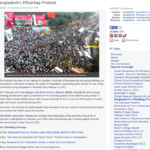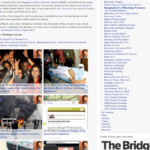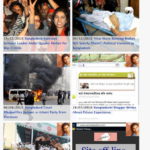 [Summary: thinking aloud – brief notes on learning about the wikidata project, and how it might help addressing the organisational identifiers problem]
[Summary: thinking aloud – brief notes on learning about the wikidata project, and how it might help addressing the organisational identifiers problem]
I’ve spent a fascinating day today at the Wikimania Conference at the Barbican in London, mostly following the programmes ‘data’ track in order to understand in more depth the Wikidata project. This post shares some thinking aloud to capture some learning, reflections and exploration from the day.
As the Wikidata project manager, Lydia Pintscher, framed it, right now access to knowledge on wikipedia is highly skewed by language. The topics of articles you have access to, the depth of meta-data about them (such as the locations they describe), and the detail of those articles, and their liklihood of being up to date, is greatly affected by the language you speak. Italian or Greek wikipedia may have great coverage of places in Italy or Greece, but go wider and their coverage drops off. In terms of seeking more equal access to knowledge, this is a problem. However, whilst the encyclopedic narrative of a French, Spanish of Catalan page about the Barbican Center in London will need to be written by someone in command of that language, many of the basic facts that go into an article are language-neutral, or translatable as small units of content, rather than sentences and paragraphs. The date the building was built, the name of the architect, the current capacity of the building – all the kinds of things which might appear in infoboxes – are all things that could be made available to bootstrap new articles, or that, when changed, could have their changes cascaded across all the different language pages that draw upon them.
That is one of the motivating cases for Wikidata: separating out ‘items’ and their ‘properties’ that might belong in Wikipedia from the pages, making this data re-usable, and using it to build a better encyclopedia.
However, wikidata is also generating much wider interest – not least because it is taking on a number of problems that many people want to see addressed. These include:
- Somewhere ‘institutional’ and well governed on the web to put data – and where each data item also gains the advantage of a discussion page.
- The long-term preservation, and versioning, of data;
- Providing common identifiers on the web for arbitrary things – and providing URIs for these things that can be looked up (building on the idea of DBPedia as a crystalisation point for the web of linked data);
- Providing a data model that can cope with change over time, and with data from heterogenous sources – all of the properties in wikidata can have qualifiers, such as when the statement is true from, or until, source information, and other provenance data.
Wikidata could help address these issues on two levels:
- By allowing anyone to add items and properties to the central wikidata instance, and making these available for re-use;
- By providing an open source software platform for anyone to use in managing their own corpus of wikified, versioned data*;
A particular use case I’m interested in is whether it might help in addressing the perenial Organisational Identifiers problem faced by data standards such as IATI and Open Contracting, where it turns out that having shared identifiers for government agencies, and lots of existing, but non-registered, entities like charities and associations that give and recieve funds, is really difficult. Others at Wikimania spoke of potential use cases around maintaining national statistics, and archiving the datasets underlying scientific publications.
However, in thinking about the use cases wikidata might have, its important to keep in mind it’s current scope:
- It is a store of ‘items’ and then ‘statements’ about them (essentially a graph store). This is different from being a place to store datasets (as you might want to do with the archival of the dataset used in a scientific paper), and it means that, once created, items are the first class entities of wikidata, able to exist in multiple collection.
- It currently inherits Wikipedia’s notability criteria for items. That is, the basic building blocks of wikidata – the items that can be identified and described, such as the Barbican, Cheese or Government of Grenada – can only be included in the main wikidata instance if they have a corresponding wikipedia page in some language wikipedia (or similar: this requirement is a little more complex).
- It can be edited by anyone, at any time. That is, systems that rely on the data need to consider what levels of consistence they need. Of course, as wikipedia has shown, editability is often a great strength – and as Rufus Pollock noted in the ‘data roundtable’ session, updating and versioning of open data are currently big missing parts of our data infrastructures.
Unlike the entirely distributed open world assumption on the web of data, where the AAA assumption holds (Anyone can say Anything about Anything), wikidata brings both a layer of regulation to the statements that can be made, and the potential of community driven editorial control. It sits somewhere between the controlled description sets of Schema.org, and an entirely open proliferation of items and ontologies to describe them.
Can it help the organisational identifiers problem?
I’ve started to carry out some quick tests to see how far wikidata might be a resource to help with the aforementioned organisational identifiers problem.
Using Kasper Brandt‘s fantastically useful linked data rendering of IATI, I queried for the names of a selection of government and non-government organisations occurring in the International Aid Transparency Initiative data. I then used Open Refine to look up a selection of these on the DBPedia endpoint (which it seems now incorporates wikidata info as well). This was very rough-and-ready (just searching for full name matches), but by cross-checking negative results (where there were no matches) by searching wikipedia manually, it’s possible to get a sense of how many organisations might be identifiable within Wikipedia.
So far I’ve only tested the method, and haven’t run a large scale test – but I found around 1/2 the organisations I checked had a Wikipedia entry of some form, and thus would currently be eligible to be Wikidata items right away. For others, Wikipedia pages would need to be created, and whether or not all the small voluntary organisations that might occur in an IATI or Open Contracting dataset would be notable for inclusion is something that would need to be explored more.
Exploring the Wikidata pages for some of the organisations I did find threw up some interesting additional possibilities to help with organisation identifiers. A number of pages were linked to identifiers from Library Authority Files, including VIAF identifiers such as this set of examples returned for a search on Malawi Ministry of Finance. Library Authority Files would tend to only include entries when a government agency has a publication of some form in that library, but at a quick glance coverage seems pretty good.
Now, as Chris Taggart would be quick to point out, neither wikipedia pages, nor library authority file identifiers, act as a registry of legal entities. They pick out everyday concepts of an organisation, rather than the legally accountably body which enters into contracts. Yet, as they become increasingly backed by data, these identifiers do provide access to look up lots of contextual information that might help in understanding issues like organisational change over time. For example, the Wikipedia page for the UK’s Department for Education includes details on the departments that preceeded it. In wikidata form, a statement like this could even be qualified to say if that relationship of being a preceeding department is one that passes legal obligations from one to the other.
I’ve still got to think about this a lot more, but it seems that:
-
There are many things it might be useful to know about organisations, but which are not going to be captured in official registries anytime soon. Some of these things will need to be subject of discussion, and open to agreement through dialogue. Wikidata, as a trusted shared space with good community governance practices might be a good place to keep these things, albeit recognising that in its current phase it has no goal of being a comprehensive repository of records about all organisations in the world (and other spaces such as Open Corporates are already solving the comprehensive coverage problem for particular classes of organiastion).
-
There are some organisations for which, in many countries, no official registry exists (particularly Government Departments and Agencies). Many of these things are notable (Government Departments for example), and so even if no Wikipedia entry yet exists, one could and should. A project to manage and maintain government agency records and identifiers in Wikidata may be worth exploring.
Whether a shift from seeking to solve some aspects of the organisational identifiers problem through finding some authority to provide master lists, to developing a distributed best-efforts community approach is one that would make sense to the open government community is something yet to be explored.
Notes
*I here acknowledge SJ Klein‘s counsel was that this (encouraging multiple domain specific instances of a wikidata platform) is potentially a very bad idea, as the ‘forking’ of wiki-projects has rarely been a successful journey: particularly with respect to the sustainability of forked content. As SJ outlined, even though there may be technical and social challenges to a mega graph store, these could be compared to the apparant challenges of making the first encyclopedias (the idea of 50,000 page book must have seemed crazy at first), or the social challenges envisioned to Wikipedia at its genesis (‘how could non-experts possible edit an enecylopedia?’). On this view, it is only by setting the ambition of a comprehensive shared store of the worlds propositional data (with the qualifiers that Wikidata supports to make this possible without a closed world assumption) that such limits might be overcome. Perhaps with data there is a greater possibility to support forking, and remerging, of wikidata instances, permitting short-term pragmatic creation of datasets outside the core wikidata project, which can later be brought back in if they are considered, as a set, notable (although this still carries risks that forked projects diverge in their values, governance and structure so far that re-connecting later is made prohibitively difficult).


 [Summary: blogging the
[Summary: blogging the 










